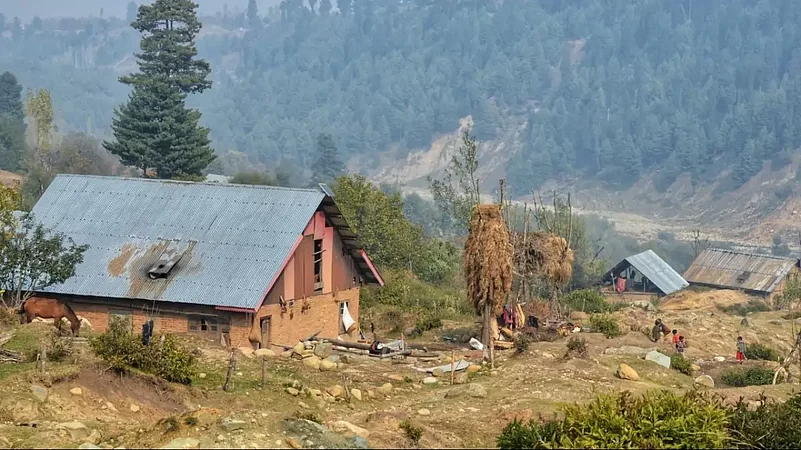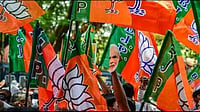Mohammad Yousuf Poor’s house is the last one in Ringazabal village on the banks of Sukhnag river, a major tributary of Jhelum. Beyond his house is the vast forest of the Pir Panjal Range of the Himalayas. Poor, now in his seventies, fell in love with the village, about 195 km from Rajouri district of Jammu. Ringazabal is around 55 km from Srinagar, in 1971. Then, there were only forests all around it and a few traditional one-room mud houses called dhoks.
“I told my father that I wanted to live in this village,” says Poor. “My father told me that Bakerwals do not live in one place.”
Bakerwals are a nomadic community that lives in Jammu and Kashmir in India and also parts of Afghanistan. They are spread over the Pir Panjal range and the Hindukush as well as Ladakh. They are usually goatherds and shepherds, and migrate seasonally from one place to another.
“My father, Sain Poor, was our guiding light,” says Poor. “He would tell us when to move with our livestock, where to halt, and where to stay.” The Poor family hails from the Kotranka area of Rajouri district in Jammu. Poor recalls that every year Sain and his five sons would trek to the Sukhnag jungles for about 40-45 days. Thousands of other Bakerwals also made this journey.
In 1991, Jammu and Kashmir recognised Bakerwals as a Scheduled Tribe along with the larger community of Gujjars. This provides them with a 10 percent reservation in government educational institutions and jobs. Besides, the Delimitation Commission in May this year recommended that nine seats out of 90 in the Jammu and Kashmir Assembly be reserved for Scheduled Tribes (ST).
However, the Bakerwals as well as the Gujjars are not happy with the Centre’s announcement in October that it was also planning to grant ST status to the Pahari community in the state. Many Bakerwals and Gujjars fear that this might dilute the opportunities they can now access, and they are planning an agitation to prevent this.
Navigating nomadism
In her book The Bakkarwals of Jammu and Kashmir: Navigating Through Nomadism (2009), sociologist Anita Sharma writes: “The pastoral Bakkarwals of Jammu and Kashmir herd goat and sheep and are a subset of the buffalo-herding Gujjars of the state. They migrate and return annually from the hills of the Jammu-Poonch region through… Pir Panjal into the Valley, to beyond the tree line atop the highland pastures of the Greater Himalayas.” Bakkarwal is another way of referring to the community.
Poor is among the few in the community who decided to settle down. His father helped him financially. “I thought if I ever live anywhere I will live here,” he says. “It is close to the jungle, the river. You can see the whole valley from here.” Finally in 1981 that he settled in the village after getting married. It is a decision he has never regretted.
His brother would come every summer with livestock from Rajouri. Poor would join them with his flock of 40 sheep on the upper reaches of the mountain. They would stay at their mud houses. Over the seven decades of his life, Poor claims to have walked thousands of kilometres.

However, younger generations are unlikely to follow the nomadic lifestyle. In Ringazabal and neighbouring villages, many Bakerwals and Gujjars are settling down, choosing other professions, and admitting their children to English-medium schools. Poors’s son Mohammed Gafoor has become a construction labourer and admitted his son to a school in Chadoora, a municipal town in Budgam district.
“My son did not want to rear livestock,” says Poor. “With livestock, you are always on the move. If they get diseases and die, you will have a miserable life. I think he has taken a good decision.” Poor adds that he wanted all his four children to study and get government jobs. “But getting them educated was beyond my means,” he says.
This year, Poor has not found much work except feeding his livestock. Across the river is Raiyar, another village. That’s where he goes to get grass from Kashmiri farmers. A visit to the village gives a glimpse of what the future might hold for the community.
Hundreds of tourists visit Raiyar every year on their way to Doodhpathri, a famous tourist destination. Their influx has changed the lives of the villages, many of whom have set up small tea stalls to serve traditional Kashmiri kawha. Some have become tourist guides, and others have turned their houses into homestays. “The children on Raiyar are going to English medium schools,” says Poor. “I want the same for our village.”
Poor’s neighbour, Bashir Ahmad Poswal, a Gujjar, agrees. “If the government constructed a proper road to our village and promoted Sukhnag as a tourist destination, our fates will change. There is no grass in the forest and most of the trees have been felled. Now, only tourism can stop wood smuggling and provide an alternative livelihood for our people.”
Poswal says economic stability might also improve the lives of his children. “I don’t want them to have the kind of hard life that I have had,” he says. Like Poor, he is worried that extending reservations to other communities might dilute the opportunities.
Demand for Rights
Gujjars and Bakerwals have joined forces under the Gujjar-Bakerwal Joint Action Committee to protest against other communities being recognised as ST in Kashmir. They have begun a protest march, Tribal Bachao March, on November 4 at Kupwara in Kashmir. It will travel through 20 districts, culminating in Kathua in Jammu — a distance of about 500 hm.
“While Gujjars comprise 19 percent of Jammu and Kashmir’s population, the literacy rate is only 2 percent,” says Gujjar leader Talib Hussain. “I doubt this figure as well. Bakerwals are always on the move and they are hardly considered in the surveys.”
Hussain says a new generation of Gujjar youth is trying to spread awareness about the need for education in the community, where many are not even aware of the reservation. “But the government’s decision to include everyone in the reservation will finish off the Gujjar tribe forever. How can the tribals compete with elite Brahmin Hindus and Peers of Kashmir?” he adds.
“All Bakerwals in spite of the ST remained backward as they were always on the move and busy with their livestock. The stationary Gujjars in Jammu didn’t get any benefit from the reservation. It is now when we started sending our children to schools they brought elites into the reservation fold,” says Hussain. “I belong to the Bakerwal family. My parents have died rearing sheep and goats. If I have got an education, it is because of the reservation. Had there been no reservation I wouldn’t have joined college and the university.”
Poor and Poswal at Ringzabal also have the same concerns. “I decided to leave the nomadic life and get my grandchildren educated,” says Poor. “Now they are in schools. But I worry they cannot compete with the rich. It seems the government wants us to be nomads forever.”


























